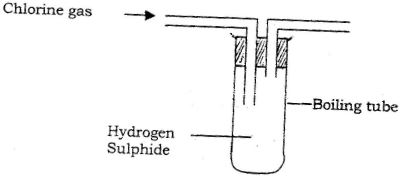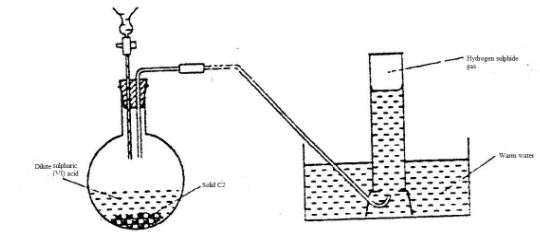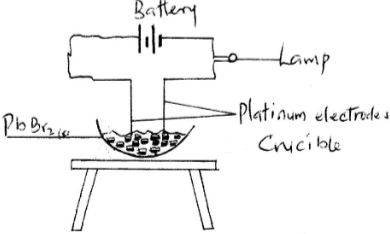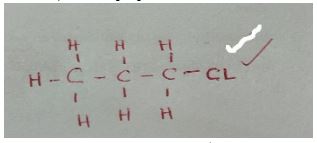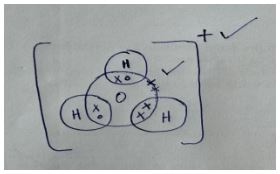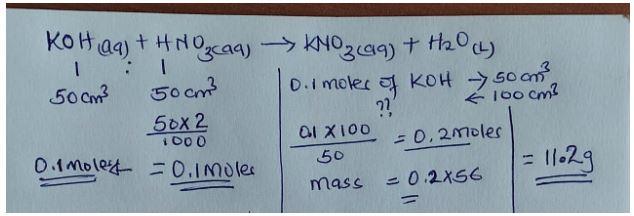- Answer all questions.
- KNEC mathematical tables and silent electronic calculators may be used for calculations.
- All workings must be clearly shown where necessary.
- Element T has atomic number 9 while V has atomic number 11.
- Write down the electronic configurations of elements T and V.
T …… (½mark)
V …… (½ mark) - State the type of bond formed when T and V combine. (1 mark)
- Write down the electronic configurations of elements T and V.
- The table below shows the Ph values of solutions I, II, III, and IV.
Solution I II II IV PH 2 7 11 14 - Which solution is likely to be sodium chloride solution. (1 mark)
- A few drops of phenolphthalein indicator were added to solution (IV). State and explain the observations made. (2 marks)
- Iron roofs usually turn brown after some time as a result of formation of rust on their surfaces.
- Explain whether rusting is a physical or a chemical change. (2 marks)
- State one way of preventing rusting. (1 mark
- State and explain the observation that would be made when hydrated copper (II) sulphate crystals are heated in an evaporating dish. (2marks)
- When magnesium is heated in air, it forms a solid Q and solid P. when solid Q is reacted with water it produces a gas W that turns moist red litmus paper to blue. Identify;
- Solid Q (1 mark)
- Solid P (1 mark)
- Gas W (1 mark)
-
- Elements X and Y has atomic number of 12 and 13 respectively, compare the electrical conductivity of elements X and Y. (1mark)
- Explain your answer in (a) above. (2mark)
- The table below shows some properties of substances A, B, C and D
Select the substance that would be most suitableSubstance Action with water Melting point Thermal conductivity A BCDUnreactive ReactiveUnreactiveUnreactiveHigh HighHighLowPoor PoorGoodGood- For making electrical cables. (1mark)
- For making cooking pot handle. (1mark)
- Propane reacts with one mole of chlorine gas under a certain condition.
- What is that condition necessary for the above reaction to take place? (1mark)
- Draw the structural formula and name the compound formed. (2marks)
-
- What is meant by solubility? (1 Mark)
- In an experiment to determine the solubility of solid x in water at 300C the following results were obtained;
Mass of evaporating dish = 26.2g
Mass of evaporating dish + saturated solution = 42.4g
Mass of evaporating dish + dry solid x = 30.4g
Using the information, determine the solubility of solid x at 30°C in g/100g water. (2 Marks)
- On strong heating, sodium nitrate produces oxygen gas. In the spaces provided below, draw a labeled diagram of a set-up that could be used for heating sodium nitrate and collecting the oxygen gas liberated. (3marks)
- Chlorine and iodine are elements in the same group in the periodic table. Chlorine gas is yellow while aqueous iodine; I2(aq) is brown.
- What observation would be made if chlorine gas is bubbled through aqueous sodium iodide? Explain using an equation. (2marks)
- Under certain conditions chlorine and iodine react to give iodine chloride, ICl3(s) What type of bonding would you expect to exist in iodine trichloride? Explain. (2marks)
-
- Give the name of each of the processes described below which takes place when the following salts are exposed to air overnight. (3marks)
- Anhydrous copper sulphate becomes wet.
- Magnesium chloride forms an aqueous solution.
- Fresh crystals of sodium carbonate, Na2CO3. 10H2O forms white powder.
- Give the name of each of the processes described below which takes place when the following salts are exposed to air overnight. (3marks)
- In an experiment, chlorine gas was passed into moist hydrogen sulphide contained in a boiling tube as shown in the diagram.
- What observation was made in the boiling tube? (1mark)
- Write an equation for the above reaction. (1mark)
- What precaution should be taken in carrying out this experiment? Give a reason. (1mark)
- Using dots (.)and crosses (x) to represent outermost electrons, draw diagrams to show the bonding in H3O+ (Atomic numbers; H = 1.0, O = 8). (2marks)
- Diamond and graphite are allotropes of carbon. In terms of structure and bonding explain the following.
- Diamond is used in drilling through hard rocks. (1mark)
- Graphite is used as a lubricant. (1mark)
- The table below gives the energy required to remove the outermost electron for some group I elements.
Element I II III IV Energy kJmol-1 494 418 519 376 - Arrange the elements in order of their reactivity starting with the most reactive. (1mark)
- Suggest possible identity of element IV. (1mark)
- X gm of potassium hydroxide were dissolved in distilled water to make 100cm3 of solution. 50cm3 of the solution- required 50cm3 of 2 M nitric acid for complete neutralization. Calculate the mass X, of potassium hydroxide. (Relative formula mass of KOH = 56). (3marks)
- State and explain how the rate of reaction between zinc granules and steam can be increased holding temperature constant. (2marks)
- The apparatus shown below was set to prepare and collect hydrogen sulphide
- Name solid C2. (1mark)
- Give a reason why warm water is used. (1mark)
- What observation would be made if hydrogen sulphide gas was bubbled into a solution of lead (II) nitrate? (1mark)
- Concentrated nitric (V) acid was added to iron (II) sulphate acidified with sulphuric (VI) acid and the mixture heated. The solution turned from pale green to yellow with evolution of brown gas. Explain these observations. (3marks)
- Describe how a solid sample of Zinc (II) carbonate can be prepared in the laboratory starting with zinc oxide. (3marks)
- But -2- ene undergoes addition hydrogenation when reacted with hydrogen gas.
- Name the product formed when but -2 – ene reacts with hydrogen gas. (1mark)
- Name the conditions necessary for hydrogenation process. (1mark)
- State one industrial use of hydrogenation. (1mark)
- The sketch below shows substance H being converted to substance J. study it and answer the question that follows.
Why do the two curves become horizontal after sometime? (2marks) - In an experiment to investigate the conductivity of substances, a student used the set – up shown below.
The Student noted that the bulb did not light- What had been omitted in the set- up? (1mark)
- Explain why the bulb lights when the omission is corrected. (2marks)
-
- State the Graham’s law diffusion. (1mark)
- The molar masses of gases W and X are 16.0 and 44.0 respectively. If the rate of diffusion of W through a porous material is 12cm3s-1 calculate the rate of diffusion of X through the same material. (2marks)
- When solid B1 was heated, a gas which formed a white precipitate when passed through lime water was produced. The residue was dissolved in dilute nitric (V) acid to form a colourless solution B2. When dilute hydrochloric acid was added to solution B2 a white precipitate which dissolved on warning was formed.
- Write the formula of the;
- Cation in solid B1 (1mark)
- Anion in solid B1 (1mark)
- Write an ionic equation for the reaction between the residue and dilute nitric (V) acid. (1mark)
- Write the formula of the;
- Hardness of water may be removed by either boiling or addition of chemicals.
- Write an equation to show how boiling removes hardness of water. (1 mark)
- Name two chemicals that are used to remove hardness of water. (2 marks)
- Study the information in the table below and answer the questions below the table.
Calculate the enthalpy change of the reaction: (3marks)Bond Bond energy (kJmol-1) C-H Cl-ClC-ClH-Cl414
244326431
CH4 (g) + Cl2(g) → CH3Cl(g) + HCl(g) - Distinguished between dilute acid and a weak acid. Give an example in each. (3marks)
MARKING SCHEME
-
- T - 2:7 √ ½
V - 2:8:1 √½ - ionic bond √1
- T - 2:7 √ ½
-
- 11 √1
- Solution changes to pink√1 since the solution is strongly basic√1
-
- Rusting is a chemical change√1 since it is - irreversible
- new substance is formed √ 1 any 1 correct -
- Electroplating
- alloying
- oiling and greasing
- painting √1 any correct
- Rusting is a chemical change√1 since it is - irreversible
- Blue crystals changes to white powder√1 the water of crystallization is lost on heating
-
- Solid Q---Magnesium Nitride/ Mg3N2 √1
- Solid P---Magnesium oxide /MgO √1
- Ammonia gas/NH3 √1
-
- y is a better conductor than x √1
- y has more delocalized electrons than x √1,the more the number of electrons the higher the conductivity √1
-
- C √1
- A √1
-
- U-V Light/ sunlight√1
- Chloropropane√1
-
- To remove the oxide layer √1
- A mixture of magnesium oxide and magnesium nitride √1
- Workability √1
-
- The colourless solution would turn brown, chloride displaces iodine from iodine solution
Cl2(g) + 2I(aq) → 2 Cl- (aq) + I2(aq) √1 - Covalent, because elements are non-metals and share electrons to bondS √1
- The colourless solution would turn brown, chloride displaces iodine from iodine solution
-
-
- Hygroscopic / Hygroscopy √1
- Deliquescent / Deliquescence √1
- Efflorescent / efflorescence’s √1
-
-
- Yellow solid formed/ yellow substance/ sulphur deposited √1
- H2S(g) + Cl2(g) → 2HCl(g) + S(s) √1
-
- In a fume cupboard/ in open air √½
- Both H2S(g) and Cl2(g) are poisonous gases (They have irritating/pungent smell) √½
-
- In Diamond all the Carbon- atoms are joined together by covalent in a three dimensions (3 –D) structure/ Tetrahedral structure thus very hard √1
- The Carbon- atoms in graphite are bonded in layers/ hexagonal strata’s, those thus slide over one another easily √1
-
- IV II I III √1
- potassium metal √1
-
- Use zinc powder (√1 ), which has a larger surface area increasing the rate of reaction(√1 )
-
- C2 = Fes, ZnS (√1 )
- H2S is soluble in cold water (√1 )
- It changes black (√1)
- Concentrated nitric acid is a strong oxidizing agent ( ½ ). It oxidizes pale green iron (II) ( ½ ) to yellow iron (III) ( ½ ) and it is reduced to nitrogen iv oxide (1) which is brown ( ½ )
- Add excess zinc oxide ( ½ ) to dilute HCl, H2SO4, HNO3 ( ½ ) Filter to obtain the filtrate, add aqueous Na2CO3, K2CO3( ½ ) to precipitate znCO3( ½ ) filter ( ½ ) wash between filter papers( ½ )
-
- Butane (√1)
- nickel catalyst √½ temperature 18°0 c√½
- Hardening of oils into fats, manufacture of margarine. (√1 )
- The reaction has stopped√1 as substance H has all been converted to J √1 yet the time is continuing
-
- Source of heat √1
- The solid PbBr2 melts √½ to form Pb2+ and 2Br− √1/2 that conduct electric current√½in the circuit. Hence the bulb lights√½.
-
- At constant temperature and pressure, the rate of diffusion of a gas is inversely proportional to the square root of its density. √1
-
-
- Pb2+ √1
- CO32- √1
- PbO(s) + 2H+(aq) → Pb2+(aq) + H2O(l) √1
-
- Ca (HCO3)2 (aq) →CaCO3(S) + H2O(l) + CO2 (g) √1
-
- Sodium carbonate (√1) Soda ash/ washing soda
- Calcium hydroxide (√1) / Lime water , Ammonia Soln;
- Sodium complex.
- CH4(g) + CI2(g) → CH3CI(g) + HCI(g)
414 + 244 = 326 + 431
BBE 658 BFE 757
4(414) + 244 = 3(414) + 326 + 431
BBE 1900 – 1999 = − 99KJ -
- Dilute acid has many water molecules and few acid molecules (1mk). Eg 0.001M Hydrochloric acid, etc (Any less concentrated acid) √½
- Weak acids dissociate partially to give few hydrogen ions and have pH of between 5 and just below 7√
Download Chemistry Paper 1 Questions and Answers - Lainaku 1 Joint PreMock Exams 2023.
Tap Here to Download for 50/-
Get on WhatsApp for 50/-
Why download?
- ✔ To read offline at any time.
- ✔ To Print at your convenience
- ✔ Share Easily with Friends / Students

